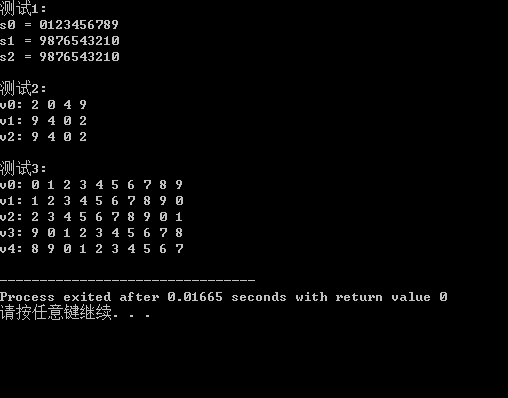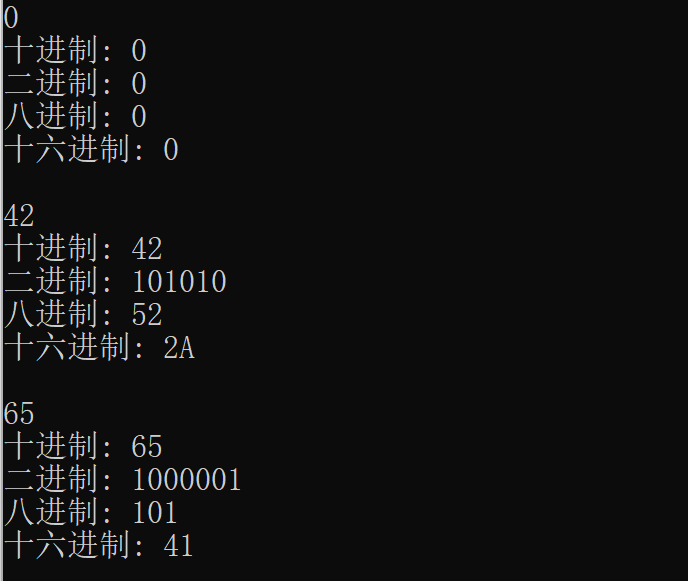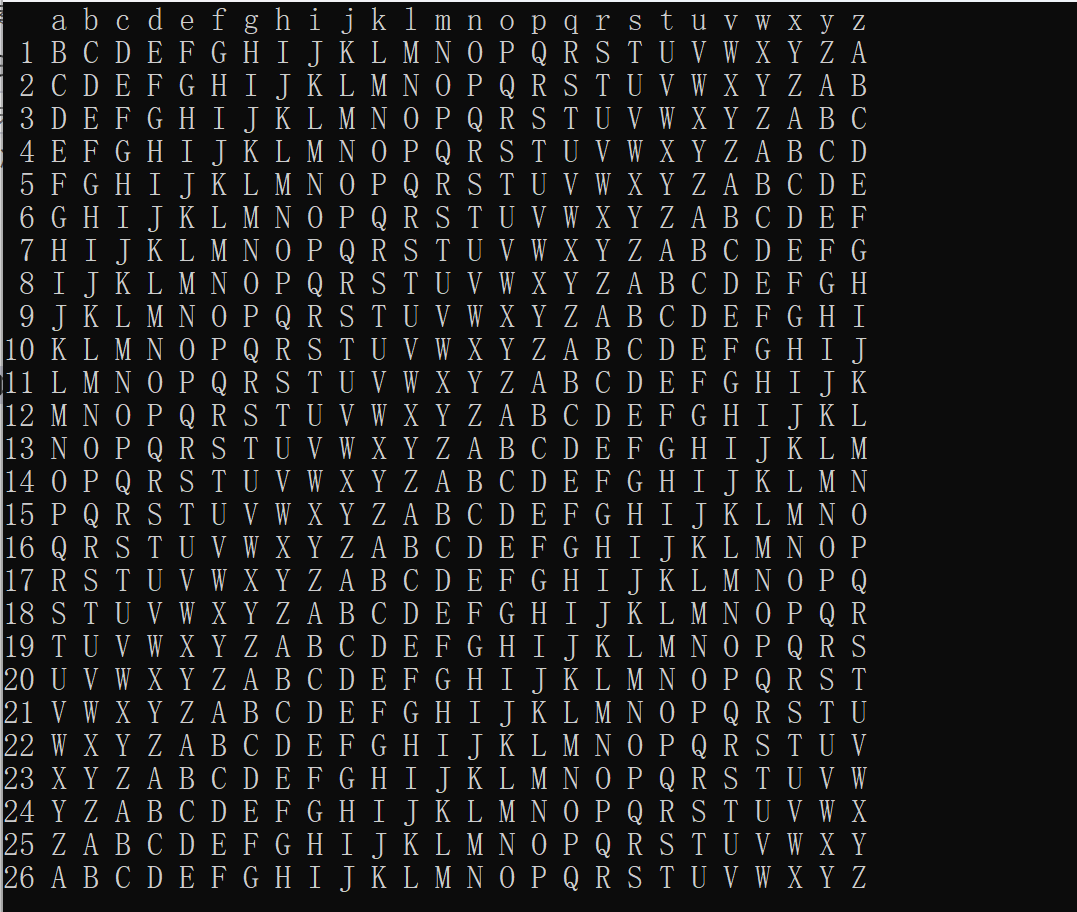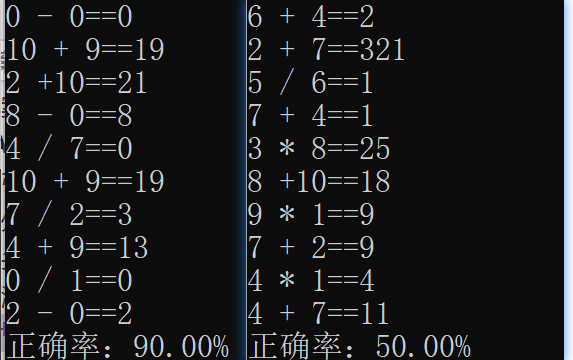实验一
实验任务1:
1 2 3 4 5 6 7 8 9 10 11 12 13 14 15 16 17 18 19 20 21 22 23 24 25 26 27 28 29 30 31 32 33 34 35 36 37 38 39 40 41 42 43 44 45 46 47 48 49 50 51 52 53 54 55 56 57 58 59 60 61 62 63 64 65 66 67 68 69 70 71 72 73 74 75 76 77 78 79 80 81 82 83 84 85 86 87 88 89 90 91 92 93 94 95 96 97 98 99 100 101 102 103 | // 现代C++标准库、算法库体验// 本例用到以下内容:// 1. 字符串string, 动态数组容器类vector、迭代器// 2. 算法库:反转元素次序、旋转元素// 3. 函数模板、const引用作为形参#include <iostream>#include <string>#include <vector>#include <algorithm>using namespace std;// 声明// 模板函数声明template<typename T>void output(const T &c);// 普通函数声明void test1();void test2();void test3();int main() { cout << "测试1: \n"; test1(); cout << "\n测试2: \n"; test2(); cout << "\n测试3: \n"; test3();}// 函数实现// 输出容器对象c中的元素template <typename T>void output(const T &c) { for(auto &i: c) cout << i << " "; cout << endl;}// 测试1// 组合使用算法库、迭代器、string反转字符串void test1() { string s0{"0123456789"}; cout << "s0 = " << s0 << endl; string s1{s0}; reverse(s1.begin(), s1.end()); // 反转指定迭代器区间的元素 cout << "s1 = " << s1 << endl; string s2{s0}; reverse_copy(s0.begin(), s0.end(), s2.begin()); // 将指定迭代区间的元素拷贝到指定迭代器开始的目标区间,并且在复制过程中反转次序 cout << "s2 = " << s2 << endl;}// 测试2// 组合使用算法库、迭代器、vector反转动态数组对象vector内数据void test2() { vector<int> v0{2, 0, 4, 9}; cout << "v0: "; output(v0); vector<int> v1{v0}; reverse(v1.begin(), v1.end()); cout << "v1: "; output(v1); vector<int> v2{v0}; reverse_copy(v0.begin(), v0.end(), v2.begin()); cout << "v2: "; output(v2);}// 测试3// 组合使用算法库、迭代器、vector实现元素旋转移位void test3() { vector<int> v0{0, 1, 2, 3, 4, 5, 6, 7, 8, 9}; cout << "v0: "; output(v0); vector<int> v1{v0}; rotate(v1.begin(), v1.begin()+1, v1.end()); // 旋转指定迭代器区间[v1.begin(), v1.end())之间的数据项,旋转后从迭代器v1.begin()+1位置的数据项开始 cout << "v1: "; output(v1); vector<int> v2{v0}; rotate(v2.begin(), v2.begin()+2, v2.end()); cout << "v2: "; output(v2); vector<int> v3{v0}; rotate(v3.begin(), v3.end()-1, v3.end()); cout << "v3: "; output(v3); vector<int> v4{v0}; rotate(v4.begin(), v4.end()-2, v4.end()); cout << "v4: "; output(v4);} |

实验任务2:
1 2 3 4 5 6 7 8 9 10 11 12 13 14 15 16 17 18 19 20 21 22 23 24 25 26 27 28 29 30 31 32 33 34 35 36 37 38 39 40 41 42 43 44 45 46 47 48 49 50 51 52 53 54 55 56 57 58 59 60 61 62 63 64 65 66 67 68 69 70 71 72 73 74 75 76 77 78 79 80 81 82 83 84 85 86 87 88 89 | #include <iostream>#include <vector>#include <string>#include <algorithm>#include <numeric>#include <iomanip>using namespace std;// 函数声明// 模板函数声明template<typename T>void output(const T &c);// 普通函数声明int rand_int_100();void test1();void test2();int main() { cout << "测试1: \n"; test1(); cout << "\n测试2: \n"; test2();}// 函数实现// 输出容器对象c中的元素template <typename T>void output(const T &c) { for(auto &i: c) cout << i << " "; cout << endl;}// 返回[0, 100]区间内的一个随机整数int rand_int_100() { return rand() % 101;}// 测试1// 对容器类对象指定迭代器区间进行赋值、排序void test1() { vector<int> v0(10); // 创建一个动态数组对象v0, 对象大小为10 generate(v0.begin(), v0.end(), rand_int_100); // 产生[0, 100]之间的随机整数赋值给指定迭代器区间[v0.begin(), v0.end())内的每个数据项 cout << "v0: "; output(v0); vector<int> v1{v0}; sort(v1.begin(), v1.end()); // 对指定迭代器区间[v1.begin(), v1.end())内数据项进行升序排序 cout << "v1: "; output(v1); vector<int> v2{v0}; sort(v2.begin()+1, v2.end()-1); // 对指定迭代器区间[v1.begin()+1, v1.end()-1)内数据项进行升序排序 cout << "v2: "; output(v2);}// 测试2// 对容器类对象指定迭代器区间进行赋值、计算最大值/最小值/均值void test2() { vector<int> v0(10); generate(v0.begin(), v0.end(), rand_int_100); cout << "v0: "; output(v0); auto iter1 = min_element(v0.begin(), v0.end()); cout << "最小值: " << *iter1 << endl; auto iter2 = max_element(v0.begin(), v0.end()); cout << "最大值: " << *iter2 << endl; auto ans = minmax_element(v0.begin(), v0.end()); cout << "最小值: " << *(ans.first) << endl; cout << "最大值: " << *(ans.second) << endl; double avg1 = accumulate(v0.begin(), v0.end(), 0)/v0.size(); cout << "均值: " << fixed << setprecision(2) << avg1 << endl; cout << endl; vector<int> v1{v0}; cout << "v0: "; output(v0); sort(v1.begin(), v1.end()); double avg2 = accumulate(v1.begin()+1, v1.end()-1, 0)/(v1.size()-2); cout << "去掉最大值、最小值之后,均值: " << avg2 << endl;} |

实验任务3:
1 2 3 4 5 6 7 8 9 10 11 12 13 14 15 16 17 18 19 20 21 22 23 | #include <iostream>#include <string>#include <algorithm>bool is_palindrome(std::string s);int main() { using namespace std; string s; while(cin >> s) // 多组输入,直到按下Ctrl+Z后结束测试 cout << boolalpha << is_palindrome(s) << endl;}bool is_palindrome(std::string s){ std::string t{s}; reverse(s.begin(),s.end()); if(s==t) return true; else return false;} |

实验任务4:
1 2 3 4 5 6 7 8 9 10 11 12 13 14 15 16 17 18 19 20 21 22 23 24 25 26 27 28 29 30 31 32 33 34 35 36 37 38 39 40 41 42 43 44 45 46 47 48 49 50 51 | #include <iostream>#include <string>#include <algorithm>#include<vector>std::string dec2n(int x, int n = 2);int main() { using namespace std; int x; while (cin >> x) { cout << "十进制: " << x << endl; cout << "二进制: " << dec2n(x) << endl; cout << "八进制: " << dec2n(x, 8) << endl; cout << "十六进制: " << dec2n(x, 16) << endl << endl; }}std::string dec2n(int x, int n) { if (x == 0) { std::string a; a = char(48); return a; } int num; std::vector<char> vec; while (x != 0) { num = x % n; x = x / n; if (num == 10) vec.insert(vec.begin(),num + 55); else if (num == 11) vec.insert(vec.begin(), num + 55); else if (num == 12) vec.insert(vec.begin(), num + 55); else if (num == 13) vec.insert(vec.begin(), num + 55); else if (num == 14) vec.insert(vec.begin(), num + 55); else if (num == 15) vec.insert(vec.begin(), num + 55); else vec.insert(vec.begin(), num + 48); } std::string s; for (auto i : vec) { s = s + i; } return s;} |

实验任务5:
1 2 3 4 5 6 7 8 9 10 11 12 13 14 15 16 17 18 19 20 21 22 23 24 25 26 27 28 29 30 | #include<iostream>#include<string>#include<vector>#include<iomanip>using namespace std;int main() { vector<char> vec1; vector<char> vec2; vector<char> vec3; for (char i = 'A'; i <= 'Z'; ++i) { vec1.push_back(i); } for (char i = 'a'; i <= 'z'; ++i) { vec2.push_back(i); } cout <<" "; for (auto i : vec2) { cout << setw(2) << i; } cout << endl; for (int i = 1; i <= 26; i++) { rotate(vec1.begin(), vec1.begin() + 1, vec1.end()); cout << setw(2) << i; for (auto i : vec1) { cout << setw(2) << i; } cout << endl; }} |

实验任务6:
1 2 3 4 5 6 7 8 9 10 11 12 13 14 15 16 17 18 19 20 21 22 23 24 25 26 27 28 29 30 31 32 33 34 35 36 37 38 39 40 41 42 43 44 45 46 47 48 49 50 | #include<iostream>#include<vector>#include<random>#include<iomanip>using namespace std;int main() { vector<int> v1{ 0,1,2,3,4,5,6,7,8,9,10 }; vector<char> v2{'+','-','*','/'}; //创建随机数引擎 random_device rd; mt19937 gen(rd()); uniform_int_distribution<> dist1(0, v1.size() - 1); uniform_int_distribution<> dist2(0, v2.size() - 1); int N = 10; int a,c; char b; double correct = 0; while (N--) { int random_num1 = dist1(gen); int random_num2 = dist2(gen); a = v1[random_num1]; b = v2[random_num2]; cout << v1[random_num1] << setw(2) << v2[random_num2]; random_num1 = dist1(gen); while (random_num1 == 0 && random_num2 == 3) { random_num1 = dist1(gen); } while (a < v1[random_num1]&&random_num2==1) { random_num1 = dist1(gen); } cout << setw(2) << v1[random_num1] << setw(2) << "=="; int c; cin >> c; int ans=0; if (random_num2 == 0) ans = a + random_num1; else if(random_num2 == 1) ans = a - random_num1; else if (random_num2 == 2) ans = a * random_num1; else if (random_num2 == 3) ans = a / random_num1; if (c == ans) ++correct; } cout << "正确率:" <<fixed << setprecision(2) << correct *10 << "%"; } |



